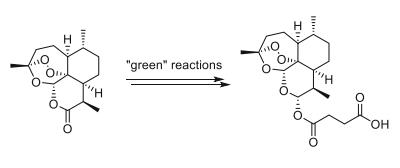Artesunate Chemische Eigenschaften,Einsatz,Produktion Methoden
R-Sätze Betriebsanweisung:
R20/21/22:Gesundheitsschädlich beim Einatmen,Verschlucken und Berührung mit der Haut.
Chemische Eigenschaften
Artesunate is an odorless bitter-tasting crystalline powder. soluble in organic solvents such as ethanol, DMSO, and dimethyl formamide, which should be purged with an inert gas. The solubility of artesunate in these solvents is approximately 20, 14, and 11 mg/ml, respectively. Artesunate is sparingly soluble in aqueous buffers.
Verwenden
Artesunate, a semi-synthetic artemisinin derivative, has been shown to be effective against parasites, such as liver flukes, and has also shown cytotoxic effects on different types of tumor cell lines. artesunate belong to Antimalarial which is clinically useful for treatment of malaria and other parasitic diseases.
Definition
ChEBI: Artesunate is an artemisinin derivative that is the hemisuccinate ester of the lactol resulting from the reduction of the lactone carbonyl group of artemisinin. It is used, generally as the sodium salt, for the treatment of malaria. It has a role as an antimalarial, a ferroptosis inducer and an antineoplastic agent. It is an artemisinin derivative, a sesquiterpenoid, a dicarboxylic acid monoester, a cyclic acetal, a semisynthetic derivative and a hemisuccinate.
synthetische
Artemisinin was discovered in the 1970s as a result of an extensive screening of Chinese herbal extracts in the search of new antimalarial agents. Currently, the primary method for the production of artemisinin is the isolation from dried leaves of the plant Artemisia annua. Furthermore, the global supply of this life-saving drug exclusively from natural sources remains highly limited. As a result, a novel approaches for large-scale production of artemisinin have been developed. Artesunate is prepared from dihydroartemisinin (DHA) by reacting it with succinic acid anhydride in a basic medium.
 A simplified and scalable synthesis of artesunate
A simplified and scalable synthesis of artesunate
Allgemeine Beschreibung
Artesunate is a semisynthetic derivative of artemisinin used to treat malaria. It has also been shown to effective against other parasites such as liver flukes. Artesunate also demonstrates cytotoxic action against cancer cell lines of different tumor types.
Mode of action
Artesunate is a water-soluble, semi-synthetic derivative of the sesquiterpine lactone artemisinin with anti-malarial, anti-schistosomiasis, antiviral, and potential anti-neoplastic activities. It acts on the electron transport chain to generate local reactive oxygen species and cause depolarization of the mitochondrial membrane. It inhibits TNF-induced proinflammatory cytokine production by inhibiting NF-κB and PI3 kinase/Akt signaling pathways in human rheumatoid arthritis fibroblast-like synoviocytes. Artesunate has also been shown to stimulate cell differentiation, arrest the cell cycle in the G1 and G2/M phases, inhibit cell proliferation, and induce apoptosis through mitochondrial and caspase signaling pathways. Artemisinin is isolated from the plant Artemisia annua.
Artesunate Upstream-Materialien And Downstream Produkte
Upstream-Materialien
Downstream Produkte

